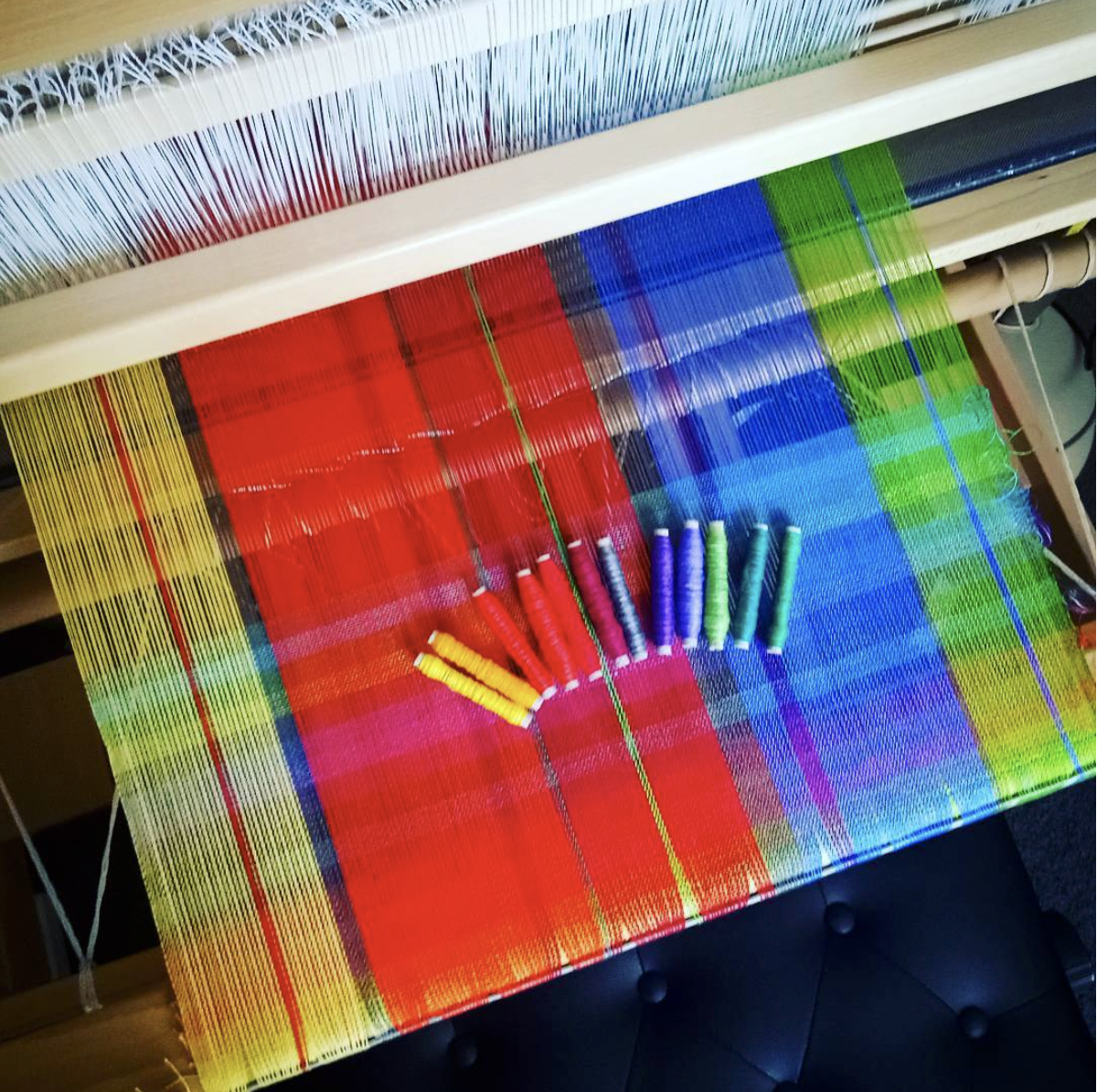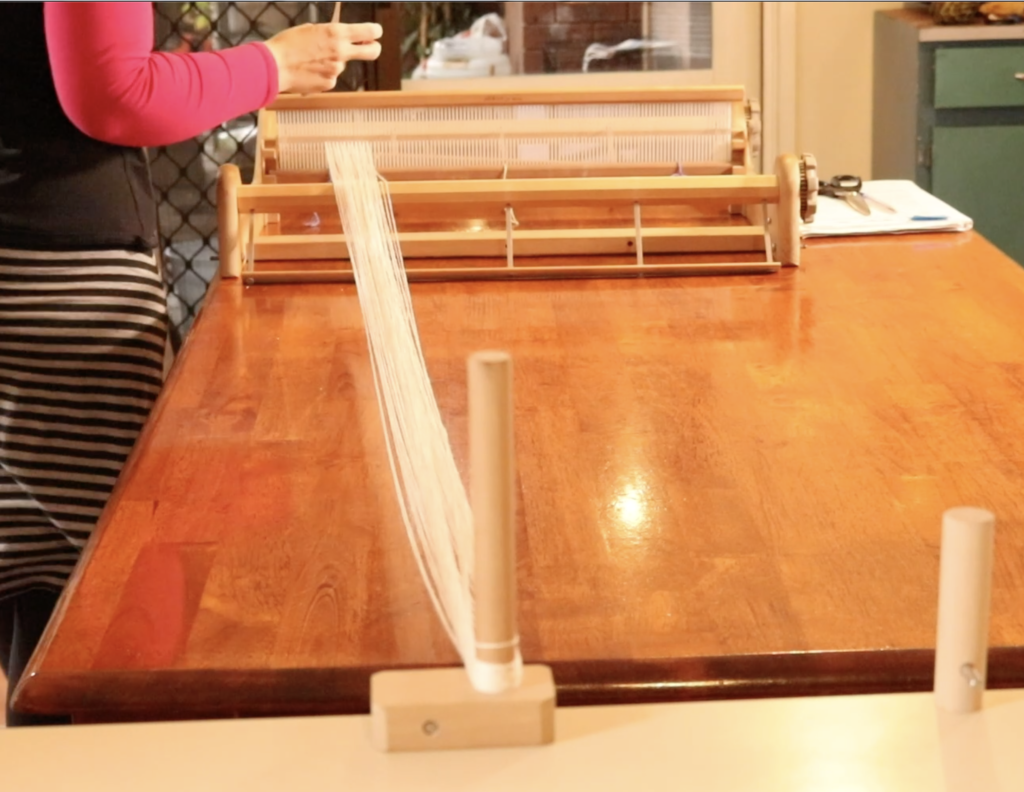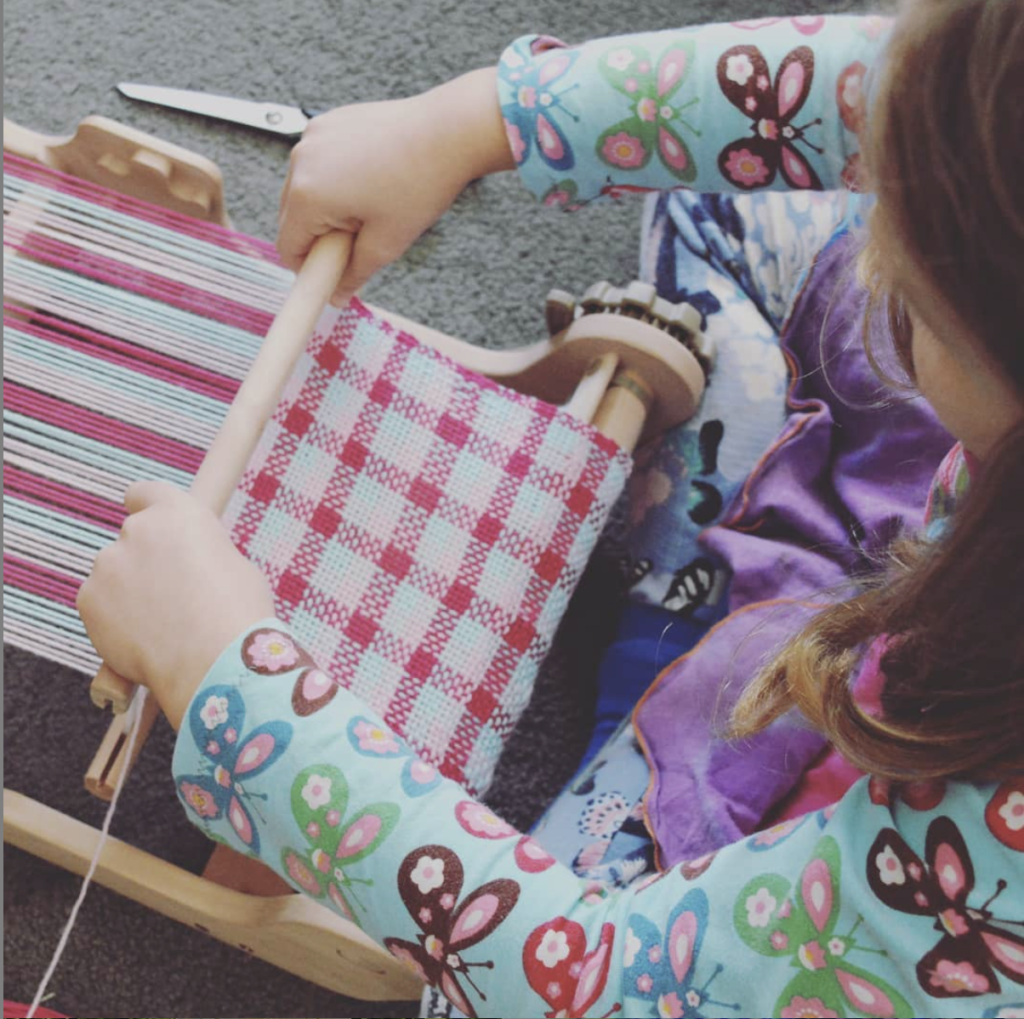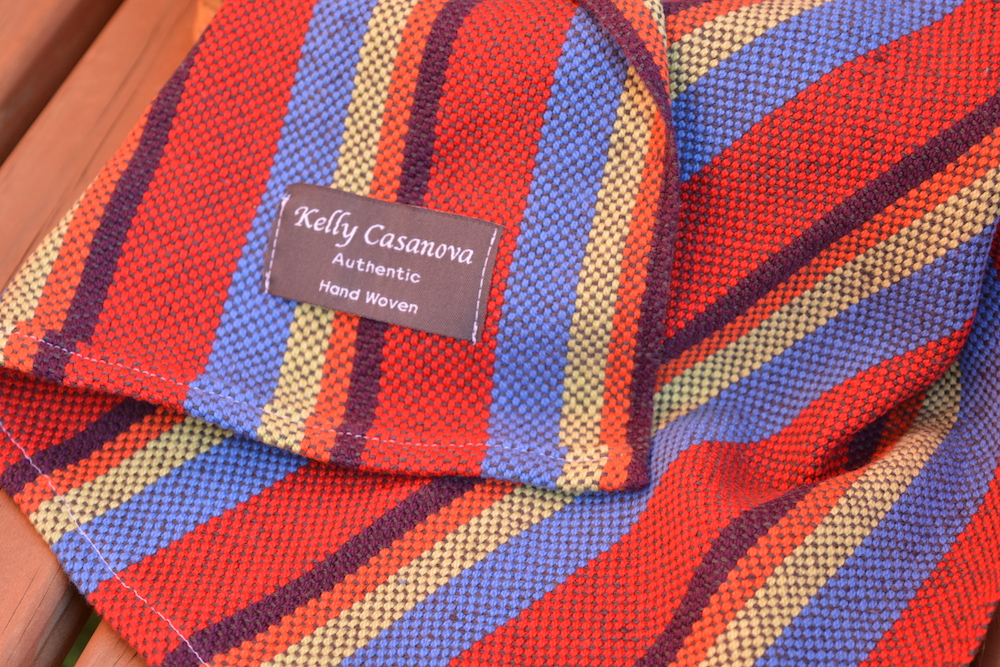Changing colours in your warp allows you to jazz up your weaving, even if it’s a plain weave project. In this article, I’m going to troubleshoot some of the issues that may arise when you want a colourful or stripey warp when direct warping your rigid heddle loom.
*This post contains affiliate links
I’m specifically speaking to rigid heddle weavers who choose to direct warp today, as these issues either don’t occur or are more simply dealt with when using a warping board, or indirect warping.
The two main issues I want to discuss today are how to most effectively deal with a warp that has a lot of colour changes and what to do when your ends are uneven in number.
If you’re not sure of the difference between direct and indirect warping, I’ll briefly explain.
Direct warping your rigid heddle loom involves tying your yarn end onto the apron rod at the back of the loom, taking the yarn through a slot, around a wooden warping peg that is clamped at the desired distance of the warp away, back through the same slot and around the apron rod again. The process then repeats.
I personally love the direct warping method for my rigid heddle loom because it is such a quick and easy process.
Indirect warping is when you make your warp away from the loom, usually on a warping board or warping mill. You then transfer and “dress” the loom with the warp. It takes longer to warp away from the loom, but is necessary for floor and table looms.
If you’re interested in seeing a warping board in action, check out this video:
Let’s talk about the first topic I mentioned, the use of multiple colours in a direct warp. When you want to make a warp with stripes, you will need to warp sections of colour. This usually involves repeating sections of colour in a sequence, so even though you’re changing colours frequently, you are often coming back to a colour you’ve already used. Many weavers ask me the best way to do this – change warp colours frequently.
There are several options.
- Tie the colours as you need them on to the apron rod, go through the direct warping process, tie on new colours as you need them but don’t cut them off when you’ve finished with one section. Then when you need to repeat a colour, you pick it up where it was last used and continue on.
2. Tie on each colour to the apron rod and then cut and tie it off on the apron rod when you’ve finished that section. Tie on the new colour to the apron rod, then tie off again when finished with that colour. Continue on across the warp.
3. Tie on to the apron rod and begin to warp, when you need to change colours cut the existing colour close to the apron rod and tie on the new yarn to the old yarn, making a firm knot. This way your thread is continuous even though you are changing colours.
I’ll share which is my favourite option and why. Number 2, wins for me, hands down. Some people are surprised to hear this and wonder why I would take the extra time to do all that cutting and tying on rather than choose to run continuous threads.
It’s a fair question and some are still not convinced when I give my reasons, but that’s ok, we’re all different in our preferences and I encourage you to do what suits you the best.
There are two main reasons why I like the tie on/ tie off method. No crossed threads. I don’t like crossed threads behind my heddle. They are messy and can cause issues like holding some threads down when they should be up and messing up my tension by crossing over the back beam in a higgledy piggledy manner – not my style at all! I can’t even show you a photo of what this looks like, as you will never see it on my loom. The second issue, as I mentioned, is the tension – I believe that my tension is compromised when those warp threads are all over the place at the back beam.
Having said all of that, there is one instance where I would consider using method one – if my colour repeats were extremely short. For example, if I was alternating between two colours every 2 ends, then I would look to decrease my warping time by continuous warping.
But I have found that most of my warps have been larger blocks of colour than that, so I always tie on/ tie off.
A perfect example where my favourite method is employed is in my Log Cabin Table Runner class. Yes, there is a lot of tying and cutting, but look at that tension! Another great example where I use the same technique is my free Wash Your Hands Towels project. I’ll readily admit that this method takes a great deal of extra time, but I also declare that the results are worth the trouble. Perhaps it’s because I’m also a floor loom weaver, and dressing the loom takes a really long time, that using the cut and tie method doesn’t feel excessively long to me. I always say to my students that extra time spent in getting a warp right is never time wasted – it will save you time later with mistakes or hiccups and you will be more pleased with the end results. Each tied section on the apron rod is like it’s own little warp with it’s own individual tension. When you come to wind them on as a whole, the tension is quite beautiful! All of those knots are on the apron rod and won’t move or affect your weaving as you advance the warp.
I didn’t tell you my thoughts on method three. I can speak from experience that it’s less than ideal. Firstly, the knots can slip or come apart, yes, even if you do them tightly. If your yarn is even slightly slippery (as in a soft cotton) you will likely have trouble. Secondly, tying yarn pieces together is more fiddly, in my opinion than tying on and off the apron rod. So, although I’ve tried this option, I now avoid it.
Now let’s discuss the second issue that frequently crops up when direct warping your rigid heddle loom, and that is what to do when your ends are uneven in number.
Sometimes you will come across a pattern or warping chart for your rigid heddle loom that may look something like the following colour sequence:
Blue – 12 ends
White – 8 ends
Red – 11 ends
White – 8 ends
Blue – 12 ends
Repeat from the beginning until you have _____ (however many ends the project calls for) ends.
It all looks good until you come to the “red – 11 ends”. 11 is an uneven number and it means that you can’t just make a loop of your thread for the last end, because then you would have 12 ends instead of the 11. Make sense?
The easiest way to get around this problem when direct warping your RHL is to not warp uneven numbers of ends! If you are designing the warp yourself, just ensure that every warp number is even so that you can loop every single thread. It might mean a little mathematical adjustment here and there, but it’s not hard and only requires basic math to figure out (I don’t say this lightly, you’re talking to a mathematics hater here!)
But what if you’re using somebody else’s patterns or instructions (by the way, you will notice that none of my patterns or classes have odd numbered ends 😉). Many patterns might be written for indirect warping, hence the odd numbers. Well, you can still adjust that pattern to custom fit it to your requirements without too much trouble.
Going back to my example colour sequence above, it would be a simple matter of rounding the “11” for red down to 10 or up to 12. Yes, you will have to rejig your initial pattern a little to allow for extra or less ends, but as I said, it’s not all that difficult.
But, if you really want to stick to the original pattern with the odd ends, there is something else you can do with your direct warp. If you warp the single colour end by itself, you will have trouble when it comes time to thread the holes. The hole thread will be missing in the place where you only took that single thread through the slot! This means that you have to use the thread from the slot, then shuffle over other threads in order to make sure all the holes and slots are threaded, thus reducing your warp size and possibly messing up your pattern if it’s meant to be threaded in a particular order. There is another way, but it has it’s own set of problems.
You take your single thread (say we’re doing the red and it’s thread 11) to the warping peg through the slot as normal. When you get to the peg, you cut the thread, leaving some spare to go around the peg and tie off. Tying off loosely with a gap is preferred, so that it comes off the peg easily when you want to wind on the warp. Then, instead of going straight back to the loom, you tie the next colour on to the peg. Following our example, that would be white. Take the white back through the same slot that the red was brought through, then back around the apron rod.
Hold up, what’s the problem with that? Well, if we take the white back from the peg, it then becomes a single. We need 8 ends of white, but now we’re going to end up with uneveness again! Further mathematical adjustments would be required or the warp will not be the width you planned for in initial calculations and once again, the pattern may be off.
You see what I mean? Isn’t it just way more simple to even out all of those numbers and save yourself a big headache? I surely think so, but if you have a different opinion or another workaround for the issue, I’d love for you to set me right by leaving me a comment 😄
OK, weavers, I think that’s quite enough for today, I hope I’ve helped rather than boggled your minds with all this!
If you haven’t already, you may want to check out my Online Weaving School, where there are many classes or memberships to choose from and catering to all different weaving levels. You will also find a range of digital download PDF weaving patterns in my Etsy Shop.
Maybe I should aim for a brief and easy going post next time!
Until then…
Happy Weaving!








I’m still new to weaving (I’ve done three simple plain-weave projects on my RH loom – over the course of two years… I’m still very intimidated by it!) and I so appreciate you sharing your hard-earned experience with us. I’m just getting ready to start my first multi-color warp project (my last project was a very basic experiment with a different warp vs weft yarn weight), and found myself stumped by warping the colors.
I’ve not been one of the people with extra time on my hands during the pandemic (my work hours have gotten longer and my leisure hours all the more precious for their scarcity), so being able to avoid common pitfalls (and therefore have more joy and successful execution in my weaving) brings me such a sense of relief and makes my weaving much more stress-relieving than the “learn-by-failure” method that so often works when one has time to spare. Thank you so much – I can’t express how your shared knowledge has eased my mind and brought so much more enjoyment to something that should rightfully be enjoyable. I hope to take one of your online classes when I finally have some time to breathe!
That is so wonderful to hear, thank you!
I’m so happy to have found this post! I am attempting my first project, a 3-colored stripped towel. I am using a warp board because I have a four shaft table loom. I looked and looked for a detailed post about how to change warp colors. So glad you talk about this! I also want yo know how to count the rotations on the warp board as compared to the warp color chart shown in my pattern. The numbers are all even on the chart, but when I halve a number six in the chart (only counting the threads on my warp board pattern starting peg,) that gives me a three. Does that mean that I should stop my thread on the last peg of my warp board pattern rather than going back to the beginning peg? Do you speak about this, in one of your blogs? I appreciate all the advice on dealing with changing colors cutting and tying and the odd and even numbers of ends. It never occurred to me to be able to change the pattern to my liking! Your post gives me hope of making the tedious & complex warping exercise a bit more fun. I’m looking forward to the sleying step next. I don’t want to get too frustrated, so I like your advice of just going with the flow and trying it. Happy weaving!
Hi Kit,
That is correct, if you have an uneven number of colours, you stop at the last peg. You can either tie it off completely, then tie on the new colour, or you can tie the new colour to the old one at the peg. Anything that happens at the last peg is going to ultimately be waste, so knots or changeovers won’t affect your warp or weaving 😉
Do you have any suggestions on how to change colors throughout a warp when using a horizontal warping mill, other than lots of cutting and tying?
Alyce, I know that some weavers will just work from continuous cones, but I don’t like doing that as I find it gets too messy for my liking. Although the cutting and tying takes extra time, I do believe it’s worth the effort for a neat, ordered warp.
I’ve spent the last two weekends warping my first striped project and you’ve confirmed what I learned the hard way. I was warping 8/2 with 433 ends with multiple color changes and odd ends. I had no idea what I was getting into! At first I did it using a warping board and warped each color separately. Then I took those chains to the heddle to thread and realized I was in trouble! Threading from the different chains was a nightmare with the thin cotton. I gave up sadly. I then decided to warp directly with tying off at the peg for the odd threads because it just made sense to me. Thank you for confirming I wasn’t crazy for doing it that way! But now I have to thread three heddles where the pattern requires certain colors end up on certain heddles. I would love to see a video on how you would thread stripes like this now that we’ve got the warping down! 😀
Wow Chris, that sounds like a bit of an ordeal, but at least you persevered and found a way that works for you!
Hi, Kelly, I was wondering, in your example with the 11 red odd-ends, the pattern repeats itself some amount of times, right? Since it does repeat, every 2 repeats of the pattern would double the uneven number of ends, making them even. Using the end-at-the-peg/begin-at-the-peg option you mentioned and threading both colors through the same slot would make all the subsequent even-ends ‘odd’, (with starting and stopping being at the peg, and 2 colors in the same slot), until you hit the 2nd odd-ends. Then the even-ends return to being even in the slots, till the next odd-ends came up. Am I right on this? And if I am, would making sure you always had even repeats be the solution for odd-ends? In a repeat, anyway?
Thanks,
Well, that’s very interesting, I had not even considered that! Again, it still depends on your pattern set up eg. if weaving Log Cabin you need the colours in the correct order and regularity to make it work – but otherwise I can’t see why it wouldn’t work 😊
Another informative and well-written article! Love, love, love that crayon colored warp!
Thank you!
Thanks for this article, Kelly. It confirmed my own preference which I’ve discovered as best for me through trial and error. I’d much rather invest a little extra time while warping so that I can really enjoy the weaving part and not fiddle with uneven tension issues!
I absolutely agree with that!
Thankyou Kelly! My present project has warp color stripes…I tied off each color change and agree it is worth the time. However I struggled with how to tie the end of the color when done with that one…I mean how to tie with a knot that will not slip. Th is was not a problem at the start of the color, just at the end of the color. Hope that makes sense!
I took this off the loom today and am waiting for it to dry …can’t waiit to see if it is drapey!!
Loraine, I just use a double knot on the apron rod to finish the cut end off and it’s never come undone.
I prefer to cut the ends every time. It makes it much neater and doesn’t take much time.
I have recently discovered that rubberized backed drawer liner works better than craft paper to wind around and does not slip. I first tried one that was too thick for a large project and went to a thinner one very successfully.
Very interesting Anita, I would like to try that myself!
I’ve used non slip shelf liner from early on, I really like it with acrylic yarn. I’ve been using plastic blind slats with cotton and like them a lot too.
I cut and tie every color change as well. I’ve tried the other ways and, as you mentioned, the tension can be an issue as well as those crossed threads. Thank you for trying everything and giving us your thoughts. I’ve learned so much from you.
Thank you so much for this information. Having just finished warping for your ‘wash your hands towels’ with all that knot tying, I have been trying to find out if I could have carried the yarns across the back beam with no response.
Having both arthritis and bad eyesight, I found it very challenging to do all those knots.
So thank you for your clarification and for everything that you have taught me. I was lucky to have discovered you from the start of my weaving journey.
Hi Kelly and everybody,
I am a beginner at weaving and French (that’s why my English is odd). I didn’t find funny patterns for beginners in French so I improve my English each time I want to weave. You, Kelly, are the best teacher I have found on You tube, the one who solved the problems I even didn’t know I could experiment !
Just thank you.
Now, I am working on a project of a foutah(Tunisian fabric) with Egyptian cotton on the warp. Gosh ! So many problems of tensions.I will tell more later and also if the 1 meter long foutah has become a hand towel 😉
Yours gratefully.
Bonjour Karine! Egyptian cotton is lovely, but very rigid – no elasticity, which makes it more challenging to warp with correct tension on a rigid heddle loom. Good on you for having a go at something different though, I hope the towel turns out well (and at it’s proper length! 😄)
Through trial and error, I whole heartedly agree with you on method 2. I will tie those knots happily. I too, have carried those colors and regretted it. Like you, if it is a short carry, I’ll do it only if I can be sure I won’t have a mess at the back. Have never tried method 3 – know of it but saw the pitfalls and won’t do it.
Hi Kelly! For the uneven thread, I was wondering if you could tie the single colour around the warping peg with loose loop, and then start the next colour on the apron bar as usual. Would that work? I’m a beginning weaver so there may be unintended consequences to this solution that I don’t see.
You could do that, but you would still have to possibly deal with unevenness of colour later when threading. Say for Log Cabin as an example, the colour order needs to be correct in the holes and slots for the design to work once you start weaving.
I’m with you on the cut and tie method. I did Log cabin and I hated having the crossed threads and continuously working them towards the back of the loom with my fingers as I was weaving. Next time I decide to do that method, even though it is a lot of cutting and tying on in the end I wouldn’t be so frustrated while weaving. Those crisscrossed threads got on my last nerve.
We definitely agree on that then! 😄
I totally agree with your comments on method #1. Tried it a few times but ended up with tension issues and crossed threads. Method #2 wins hands down.
Glad you’ve found the best method for you 😊
Thank you, this was very helpful. I‘ve just finished a project with a lot of color changes. I used your method 1 and was not happy with ist. Next time I will follow your advice and use method 2. By the way: I’m not sure whether I understand what you mean by „crossed threads behind the heddle „? Is that anywhere explained in one of your videos?
I mean that at the apron rod there would be threads crossing over one another rather than sitting straight and in order on the rod.
I’m with you on tie on/tie off for each colour change, no matter how small. For my houndstooth scarf, with alternating colours every two threads, I kept the threads continuous – did not like it at all! When it came to threading, it ‘felt’ like the threads were catching on each other. Not sure how much my tension was compromised as it was an early project and I was still having issues controlling tension anyway. After that, I’ve cut and tied every time and will continue to do so. I like the neatness it gives and my threads feel ‘happier’.
Yes, exactly! 😄